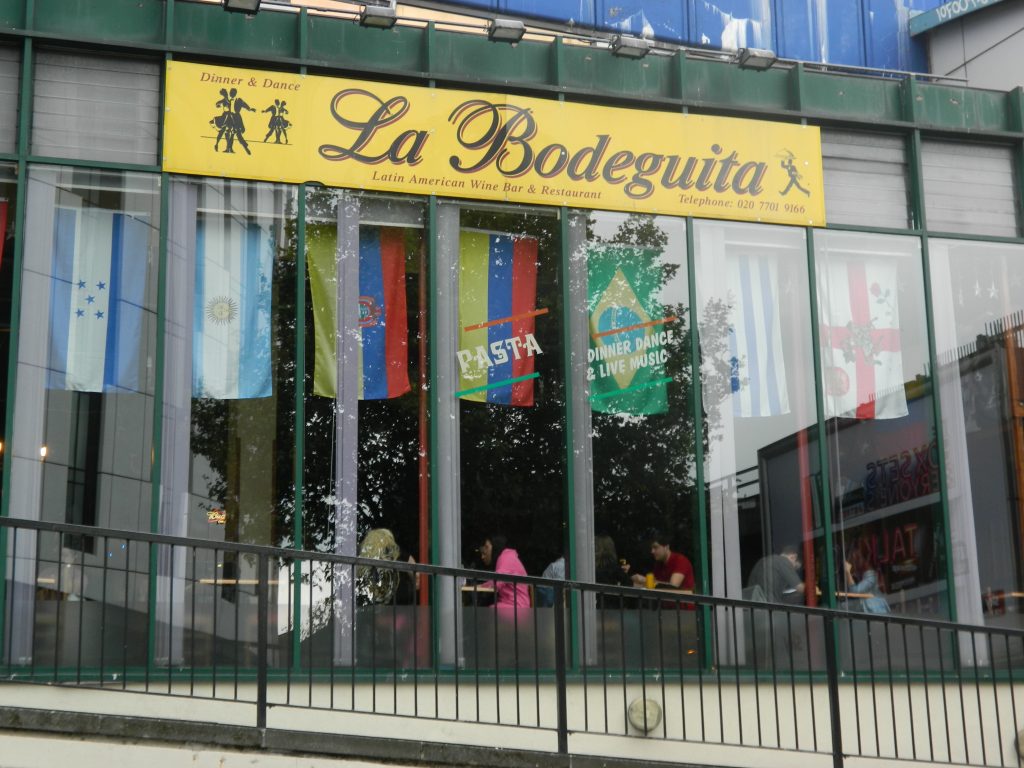This blog draws from my experiences working in a participatory video and photography project entitled My Latin Elephant. The project sought to document Latin Americans’ experiences at Elephant and Castle. Participatory methods provide an archive and repertoire for future political action. At the very least, the project asserts our presence in the context of intense urban erasures, writes Ulises Moreno-Tabarez
_______________________________________________
Demolition of the Elephant & Castle (E&C) Shopping Centre is underway. To write this blog entry, I began sifting through my archive, searching for content about the area from the ethnographic research I conducted for my PhD project. E&C became an area of intense focus for me from August to December 2015. The experiences that stand out the most were part of a project using participatory photography and video methods. Latin Elephant organised the project in association with InsightShare and Fotosynthesis. It comprised eight workshops using these art-based methods to create visual narratives about what E&C meant to us and the users we encountered in our exploratory research in the area. From this project, we collectively produced a short video entitled, Being Latin in Elephant/Ser Latinx en Elephant, and a photography community exhibition of the same name from 28 November to 15 December 2015 and a subsequent dossier entitled My Latin Elephant. This blog is a kind of play in memory, drawing from the archive to build on the repertoire and vice-versa. In the act of reminiscing, I provide a participant’s assessment of what we did and what we left behind, underscoring the importance of participatory methods for urban studies and human geography, at large.

The act
It’s been five years since I took part in this project. I am currently living in the Costa Chica region of my home state of Guerrero, Mexico, conducting ethnographic research employing participatory methods to document environmental racism by way of state-led development projects. My memories of taking part in the Latin Elephant project are some of my fondest of conducting fieldwork in London. It took away from the various configurations of solitude that engulfed not just my PhD life, but my life in general at the time.
We began our workshops in September after Delancey had presented initial proposals for the new E&C town centre and while Elephant Road was under redevelopment. Latin Elephant chose fifteen participants; twelve of us made it through to the final workshop and exhibition. Each of us had different, though interrelated, experiences and relationships to E&C.
We met Mondays and Fridays for eight-core sessions covering video and photography techniques, participatory cartography, interviewing techniques, local history and changes, visual storytelling, storyboarding, and collective editing for video and photographic data. In teams and alone, we took pictures, recorded video, and interviewed local business owners, service providers, and users of the area. During and after the event, we shared a common feeling that it was all too short; short on time, technical training, historical and sociopolitical context, and, most of all, social bonding. Yet, we managed to put it all together with special thanks to Ingrid Guyon and Soledad Muñiz, the photographic and video editors (respectively). They worked arduously to put our collective work and imaginations together.

The archive
In assessing what performance studies brings to methodology, Diana Taylor (2003) encourages a participatory relationship between the archive and the repertoire. From a subject’s perspective, the archive is the written wor(l)d outside while the repertoire is the spoken wor(l)d inside. This duality takes on a broad metaphorical life as it is central to western epistemes, particularly scientific research methods where the academic assumes the writer’s role (memory/knowledge producer). In contrast, the research subject takes on the part of the speaker (embodied-knowledge producer). Participatory art-based methods can potentially disrupt this arbitrary and false dichotomy to produce and transmit knowledge as embodied memory. That’s what we left behind with the My Latin Elephant project.
For me, the project underscored the multiple roles researchers must take on as writers/readers and as speakers/listeners. Furthermore, participatory methods call for the need to facilitate spaces where research participants can produce these dialectical subjectivities. Reading and rewatching our collective video’s subtext, I am unclear if we, the twelve workshop participants, played the crucial roles for our research participants, facilitating spaces to voice critical perspectives. I recall the sense of urgency and angst our video induced in the audiences that attended the exhibition’s viewing sessions. There was a sense of preemptive grief, generalised anger, and puzzled uncertainty about what was to come and what we were going to do about it. Macarena Gajardo-Sheridan, a fellow workshop participant, and I hosted these sessions. Still, Patria Román-Velázquez, Founder and Chair of Latin Elephant, had to field some of these questions, as her work and experience in the area was far more extensive than most of us combined. This situation opens the question that Rachel Pain (2004) asks about the limits of participatory methods: where and when does participation end and for who? Here, I am thinking about the audience and the need for participatory methods to create open-ended archives that elicit and channel emotions as/into political actions.

The repertoire
In its various constellations, the repertoire includes emotions as/in political actions (Pain 2009). The archive we produced evinces complexity and multiple realities and sentiments towards the then-tenuous plans for demolition of the E&C Shopping Centre. Some of the people we interviewed were in favour of redevelopment, some against, and others just worried. What comes through in the afterlives of these archives can be summed up with the phrase ‘we were here’. We evince a sense of presence resisting spectralisation. As long as the archive stands, so will the potential for a repertoire instantiating politicised anger, grief, angst, empowerment, and hope in the context of intense urban erasures.
Patria Román-Velázquez and Santiago Peluffo Soneyra, a fellow workshop participant, continued the struggle against unjust redevelopment plans. Alongside other campaigners, they continue to advocate for Black and (Migrant) Minority Ethnic traders left out of the redevelopment plans, including relocation to suitable and affordable commercial space. 35% Campaign has also continued the struggle, advocating for affordable housing, highlighting the overwhelming amount of overseas investment, and Delancey’s tax avoidance, which is said to use a complex offshore company network. A coalition of different stakeholders, including traders, residents, tenants, trade unionists, and campaign groups, called Up the Elephant, have crowdfunded a legal challenge to increase social housing, scheduled to be heard by the Court of Appeal on the 16/17 March 2021. Up the Elephant‘s page has a wonderful archive of participatory video projects, including our Latin Elephant project.
Conclusions
For urban studies and human geography writ large, participatory methods provide disruptive opportunities of archaic binaries designed to bifurcate the academy from community, or, at the very least, from community-building efforts. Power and empowerment are core issues engendered in the use of participatory methods (Kindon, 2003). This is not to say that participatory methods are inherently empowering, but rather that they need continual and contextual negotiation between academics as facilitators and co-knowledge producers (Milne, Mitchell, & Lange, 2012). In large metropoles and small cities to anywhere in between, participatory methods provide possibilities for recreation, education, and advocacy. They are essential tools for geo-graphy, the co-writing of the earth where memory, like that of an elephant, can work towards emancipatory political projects.
References
Latin Elephant with InsightShare and Fotosynthesis. (2015). Being Latin in Elephant / Ser Latinx en Elephant. Latin Elephant YouTube Channel.
Milne, E-J., Mitchell, C. and de Lange, N. (eds.). (2012). The Handbook of Participatory Video. Lanham: AltaMira Press.
Pain, R. (2004). Social geography: participatory methods. Progress in Human Geography 28(5): 652–663.
Pain, R. (2009). Global fear? Towards an emotional geopolitics. Progress in Human Geography 33(4): 466–486.
Román-Velázquez, P. (ed.). (2016). My Latin Elephant: Workshop in Participatory Video and Photography. London: Latin Elepahtn, ,CIO.
Taylor, D. (2003). The Archive and the Repertoire: Performing Cultural Memory in the Americas. Durham: Duke University Press.
_______________________________________________
About the research
The experience described in this blog was part of the ethnographic work I conducted for my PhD thesis. My research examined the relationship between Latin American migrants and small charities in London. From this work, I am developing an article critically examining how methods contribute to the production and performance of ethnic subjectivity.
For citation: Moreno-Tabarez, U. (2021) We were here: participatory methods and their afterlives at Elephant and Castle. Field Research Methods Lab at LSE (21 April) Blog entry. URL: https://blogs.lse.ac.uk/fieldresearch/2021/04/21/we-were-here-participatory-methods-and-their-afterlives-at-elephant-and-castle/





